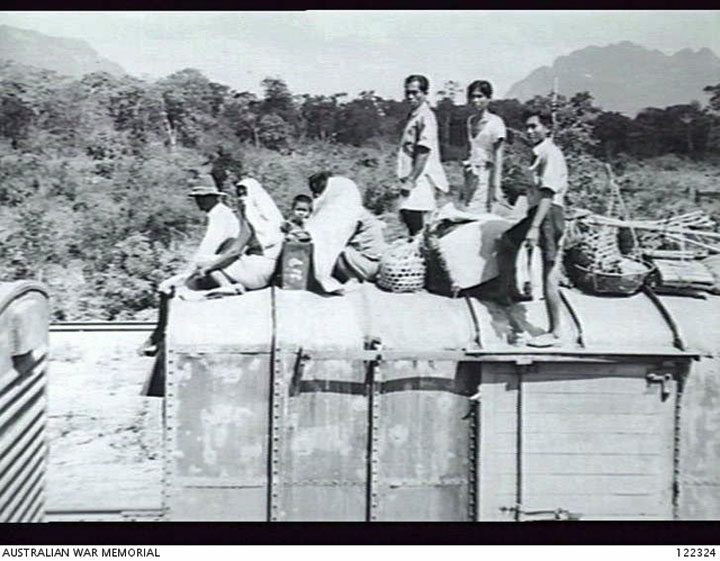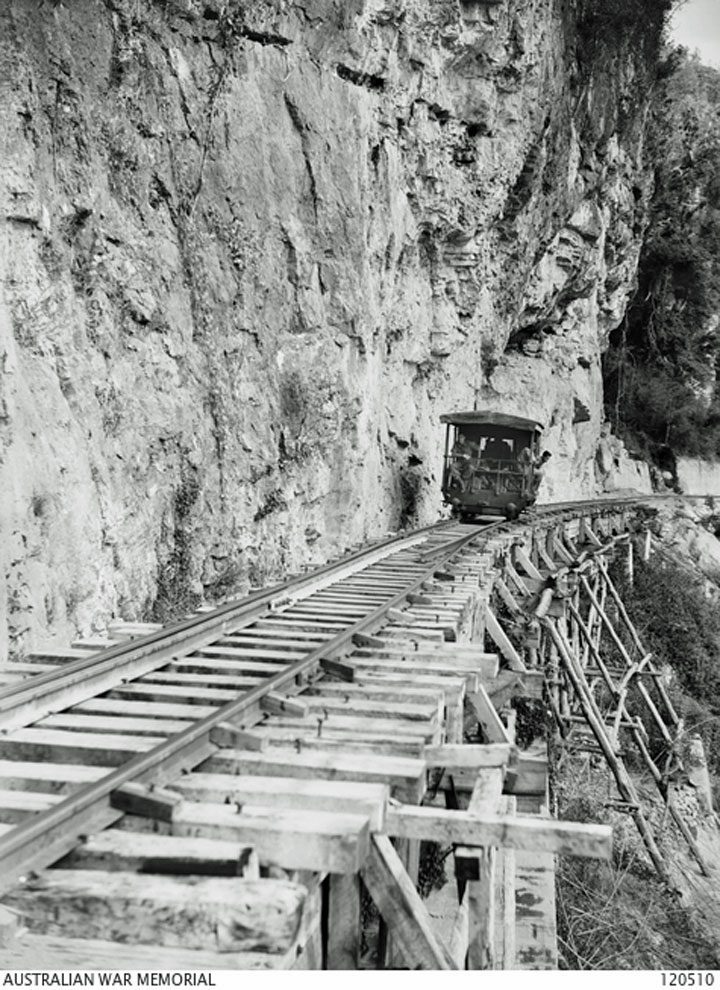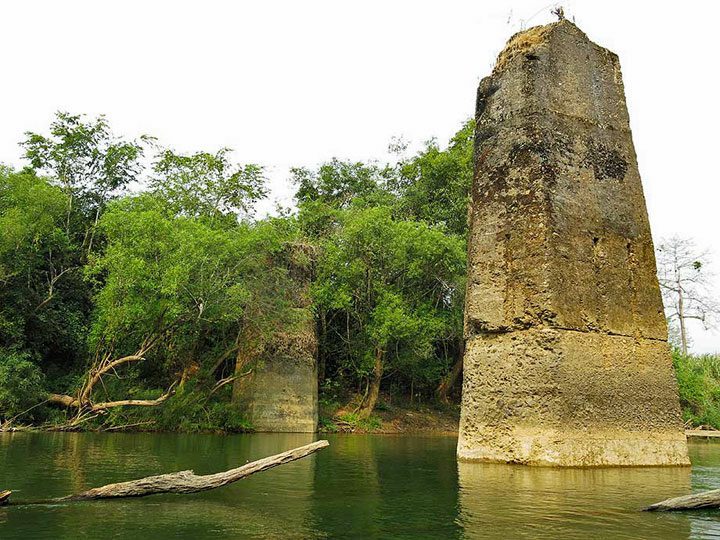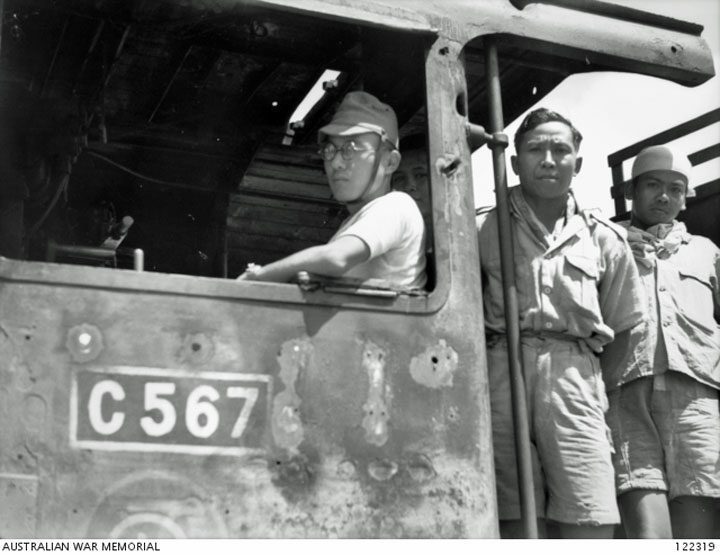What happened to the Railway of Death?

Travelers after the war
Japan capitulated on August 15, 1945. With that, the Thai-Burma railway, the infamous Railway of Death, lost the purpose for which it was originally built, which was to bring troops and supplies to the Japanese troops in Burma. The economic usefulness of this connection was limited and it was therefore not very clear after the war what to do with it.
The railway on the Khra Peninsula had been all but dismantled in the last months of the war, but the Thai-Burma line was still used sporadically. On a beautiful photo that is in the impressive photo archive of the Australian War Memorial is recorded shows how in November 1945, a few months after the Japanese capitulation, a Japanese prisoner of war is assisted by two Thai drivers on one of his journeys with the Japanese C56 locomotive No. 7 on the Railway of Death.
However, on January 26, 1946, this connection also came to an abrupt end when the railway on the Burmese side was broken up on British orders. A British engineer battalion broke up rails a few kilometers from the border, but it is not clear what happened to it afterwards. Most of the tracks on the Burmese stretch were, according to various reports, illegally demolished shortly afterwards by Karen and Mon and sold for scrap to the highest bidder. The sleepers, bridge piers and embankment were left useless and it was not long before they were swallowed up by the again rapidly advancing jungle.
The fact that Thailand hardly had to account for its controversial attitude during the war did not sit well with the British in particular. And they made no secret of their dissatisfaction. For example, it was not until June 1946 that the Thai government recovered part of the 265 million baht it had placed in reserve in London before the war. At the start of hostilities, the British had frozen this credit. One of the other precautionary measures that the British troops took almost immediately upon entering Thailand was the receivership of the railway infrastructure and rolling stock that had been left behind by the Japanese troops.
Sometime in April 1946, the British chargé d'affaires in Bangkok sent a letter to the Thai government stating that, in view of the fact that the Japanese had stolen tons of railway equipment in Malaysia, Burma and the Dutch East Indies, it was before any possible demolition of the railway it would be fair that they were compensated for this theft. He thought it would be a good idea that Thailand would compensate them. Japanese prisoners of war and allied troops were still in the country and could be made available by the British for the demolition of the railway. After some discussion within the Thai government and especially the insistence of the Ministry of Transport & Transport, it was decided to purchase the railway because there was a great lack of spare parts due to the post-war scarcity.

Wamp bridge
Bangkok asked the British to draw up a price quotation that also provided for the demolition of the line. The Thai government, which was prepared to give a lot of water to the wine for the sake of keeping the peace, may have had to swallow when the British came up with a price tag of 3 million baht for this operation. After much discussion, both parties finally reached an agreement in October 1946. The railway, including the abandoned rolling stock, was purchased for 1.250. 000 million baht. In the end, the railway line that had cost so much blood, sweat and tears was not dismantled. Only the stretch between the Three Pagodas Pass and Nam Tok, which was better known as Tha Sao in wartime, had to suffer. Contract workers from the Thai National Railways - the same company that had pre-financed a large section of the Thai-Burma Railway in 1942-1943 - demolished this section between 1952 and 1955. In 1957, the Thai Railways reopened the section of the original railway line between Nong Pladuk and Nam Tok, which is still operational today. Many travel agencies in Bangkok advertise with 'spectacular trips on the real Railway of Death'… A somewhat tasteless offering of 'entertainment', to say the least, that I've been wondering about for some time… But nobody seems to care about that…

Bridge piers broken line at Burmese Apalon
Perhaps it is an ironic twist of history that the Tha Makham Bridge - the famous Bridge over the River Kwai – was restored by the Japan Bridge Company Ltd. from Osaka…
Oh yes, by way of conclusion, this for the doubters of the theory that history in fact consists of recurring cycles: In 2016, the People's Republic of China announced that it wants to invest 14 billion dollars in a new Thai-Burmese rail link. This ambitious concept is part of the plans for a high-speed rail line to connect Kunming, the provincial capital of China's Yunnan province, with Singapore via Bangkok. A railway with a length of no less than 4.500 km. At least 100.000 workers would need to be deployed for the yards on the stretch in Laos alone. This line would include a branch to the Burmese coast, connecting China not only with the Gulf of Thailand but also with the Bay of Bengal. As part of the even more grandiose Chinese pan Asia Railway Network there are also serious thoughts about the construction of a second railway from Kunming through Vietnam and Cambodia to Bangkok.



My father-in-law had to work on that railroad and just survived.
After August 15, he was still far from going home (Sumatra) and spent another 7 months in Thailand, where he could recuperate.
He now had so much experience in building a railway line that it was built under his leadership in the Sultanate of Deli on Sumatra!
Building a railway line in the Sultanate of Deli?? In what year? After the war?
Last year in December we did a 3 day scooter trip, Kanchanaburi up to the 3 pagoda pass. 2 nights accommodation in Sankhla buri. Beautiful ride if you take the time. There are several places that are more than worth visiting. Especially the hellfire pass is impressive
Gret Philip
Thanks again for this nice contribution Jan! I don't always reply but appreciate all your bits. 🙂
Thank you Jan,
My girlfriend's father from Ned had to work on this railway line as a Dutch officer in the KNIL army.
185 cm and then weighed 45 kg!! He came out on top and was able to enjoy his pension at Bronbeek, until his death! Then he weighed three times!!
We also made the train ride. Impressive. In Kanchanaburi we visited the cemetery where the many Dutch people lie and also visited the museum. When you see the rows of graves there, you are silent for a moment. You should also have visited this, to get a better picture of it.
It's terrible what people can do to each other, I've also been in the hellfire pass and heard what happened it's not normal how people can be. Two days it kept flashing through my head but I didn't want to miss it, knew not that they were cruel. Of course, something like this must never happen again.
For those who want to read more about the railway shortly after the war (which was in “hands” of the Dutch in 1945-1947) I can recommend this book: https://www.shbss.org/portfolio-view/de-dodenspoorlijn-lt-kol-k-a-warmenhoven-128-paginas/
Incidentally, there are more very interesting books available on that website about the construction and the personal experiences of prisoners of war.
Allow me to also mention the role of some Thais who helped the forced laborers on the Death Railway. That happens too little.
https://www.thailandblog.nl/achtergrond/boon-pong-de-thaise-held-die-hulp-verleende-aan-de-krijgsgevangenen-bij-de-dodenspoorlijn/
Tino, maybe also mention the Thai government that they didn't do much to make it difficult for the Japanese….